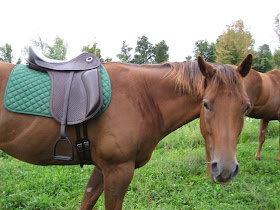You may or may not have noticed that my previous hoof posts were suspiciously lacking in some pretty important structures. I was aware of their absence, the problem was that I still didn't really understand how they worked. Fortunately I got some insight in Oregon.
Have you ever heard that the hoof should be divided into thirds as shown by the photo below?
 |
| Photo from Yvonne and James Welz |
There's a reason for that:
The back 2/3 of the hoof absorbs shock.
Since horses weigh quite a bit it makes sense that most of the foot should be devoted to energy dissipation, right? Okay then. Three important structures make up the back of the hoof: the digital cushion, the live (sensitive) frog, and the lateral cartilages.
The Digital Cushion
You could think of the digital cushion as the horse's gel insole, its only function is to absorb shock. When horses are born the digital cushion is simply a mass of fatty tissue, as they grow and move that fatty tissue becomes denser and cartilaginous. This is a good thing: thicker, tougher digital cushions are better able to withstand the pressure of a thousand + pound horse running around on them. Below is a picture of a nice, fat digital cushion- it's the white bit between the red of the coffin bone/corium and the grey of the frog.
 |
| Photo from I don't remember where, probably one of Cheryl's |
Digital cushions need lots of heel first landings to develop but, sadly, a lot of domestic horses don't get them. Due to containment practices (stalling), shoes, and untreated disease lots of domestic horses suffer from poorly developed digital cushions. You can check your horses' digital cushions like this:
 |
| Photo from the Natural Hoof UK |
They should resist your fingers when you squeeze, if they're soft and spongy then you've got a problem. The good news is that any horse at any age can develop strong digital cushions given the right conditions. The
Rockley Farm blog gives some great examples of that. Whenever they show pictures of their rehab horses' improved heels what you're actually seeing is the development of the digital cushion.
The Live Frog
The live frog sits directly underneath the digital cushion, it is made of a solid, rubbery material that acts like a trampoline and produces the frog callus that we are so used to seeing and fretting about (at least I fret about it). Can you see how it's folded up like an accordion? That allows it to stretch and flatten under the digital cushion as the horse weights the foot, when the foot is unweighted the live frog springs back to its original shape.
 |
| Photo from Cheryl Henderson |
I included this second photo so you could place what you were looking at in the above picture. Like the digital cushion, the live frog is also susceptible to negative forces, especially thrush. With bad cases of central sulcus thrush the live frog will get eaten away, weakening the structure and thus destroying an essential part of the hoof mechanism (I'll describe the hoof mechanism in another post).
 |
| Photo from Cheryl Henderson |
The Lateral Cartilage
Raise your hand if you've heard of the lateral cartilages before (as if I could see you). I'm guessing most of you aren't raising your hand. That's too bad because they are quite important, not only are they key factors in the hoof mechanism, but they also contain lots and lots of blood vessels (and one exciting revelation- read on).
Each hoof has two lateral cartilages that are set up as mirror images of each other around the bones and digital cushion. They are located inside of the corium and have multiple attachments: They attach to the hide above the coronet band, the coffin bone, and P2.
 |
| Collage and photos by Cheryl Henderson |
Here's the exciting revelation:
The bars of the hoof grow from the lateral cartilage.
Okay, so maybe that's not as exciting as winning the lottery but it's still an important finding. It means that one side effect of leaving the bars alone and letting them overgrow is that they "jack up" the lateral cartilages which displaces them, squishes them, and basically keeps them from doing their job. Here's a rule of thumb for you: if you have to trim the walls then you will also have to trim the bars. If the horse isn't moving on enough abrasive footing to self-trim the walls then they aren't self-trimming the bars either.
Get it? Got it? Good.














